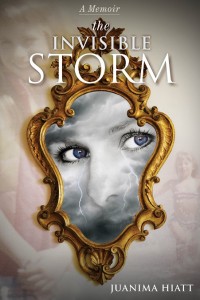What You CAN Do to Support a Trauma Survivor
Now that we’ve talked about what not to do/say when trying to help someone who is suffering from PTSD, it’s time to address when family and friends CAN do.
Life coach and PTSD survivor Juanima Hiatt is back again to explain how people can help. She wrote about her own path to peace and sanity in The Invisible Storm, now available on Amazon.
Providing helpful support to a trauma survivor
Laura — What are three of the best ways to provide support to someone actively trying to heal from trauma?
Juanima — Take it as a HUGE positive sign when someone decides to heal. It takes incredible courage to face this beast, and it’s a long, difficult journey that often gets worse before it gets better. Here are three good ways to be a good support person:
The more you know and understand about this disorder, the better support person you’ll be. Get your hands and eyes on good resources; there are tons of websites and books out there that will open your eyes to what your loved one is dealing with. People who have read The Invisible Storm write to me and say, “I feel like I get it now.” That’s music to my ears because people need that understanding to be a strong, non-intrusive support in the sufferer’s journey of recovery. Just remember that it’s a unique battle for every person, so the information you read isn’t necessarily what the sufferer is going through exactly, which leads to my next tip.
(2) Communicate.
PTSD is a frightening experience, not only for the sufferer but for their loved ones as well. It’s all too easy for the sufferer to isolate and shut everyone out as a means to contain what’s happening inside them. Don’t barge in. Give them space, but offer your non-intrusive presence, love, patience, and encouragement. Ask how you can best help and support them. Tell them you have no idea what this is like for them, but you want to be there in whatever capacity is helpful to them.
(3) Get support for yourself.
I put my family through hell during those early years of PTSD. I can see now the impact my battle had on everyone around me, but I was so isolated and in so much pain then, it was difficult to see it clearly.
If you’re living with someone battling PTSD, make sure you have a friend you can vent to, and consider seeing a therapist occasionally who can give you your own set of coping tools and help keep you on track as a support person. It’s worth it, because the tremendous shift in the sufferer’s personality and identity will be a shock, to say the least. It’s common and understandable for friends and family to experience feelings of anger, fear, doubt and uncertainty, frustration, impatience, and irritability. They may feel stretched thin at times and unsure of how to go on.
But if you have your own support system, do your best to communicate with your loved one who suffers, and get educated about PTSD, it increases chances of healing for all.
* * * * *
Missed the past two interviews with Juanima? Check them out here–
- Part 1 — PTSD, Not Only for Ex-Soldiers
- Part 2 — PTSD and Post-Adoption Issues–What NOT to Say
About – Juanima Hiatt is the mother of two girls, a life coach, speaker, and author. Her compelling memoir, The Invisible Storm, portrays her battle with PTSD and what it takes to overcome the disorder. Her uplifting blog focuses on healthy living, PTSD, and positive life change. Juanima is currently working on a YA novel series, and has a political thriller in development as well, but prioritizes helping people through her coaching practice to transform their life from a place of stagnancy and frustration, to balance, joy, and complete freedom. Contact her at juanimahiatt@gmail.com.
“Stones And Water” by njaj







Dear Laura and Juanima,
I appreciate this important interview–simple but powerful ways to help those suffering from PTSD. Your courage and willingness to share your painful experiences so openly will go a long way to increase awareness and give hope to those who need it most–the PTSD sufferer and those who love them as well as health care providers who are in a position to intervene and make a positive difference. I especially appreciate your statement about a acknowledging a "person's willingness to heal " as a positive step in the right direction. Thank you both for all you do to help others.
Thanks, Kathy — I agree. Juanima is pretty amazing, she's gotten her PTSD under "control," and now she's postively reaching back to others who are still struggling. It's been so great to have here on my blog
I have read Juanima's memoir and we conected via e-mails and phone calls. I have not known anyone personally who expressed suffering from PTSD, however, I just spent time in Paris with my 88-year-old dad. I interviewed him about his years in a camp during WWII from 15-19, as a British citizen in occupied France. He has never expressed PTSD, but after our interview, I know he had some traumatic moments. Are older men more likely to just not talk about it?
I appreciate your statement Juanima, "Don’t barge in. Give them space, but offer your non-intrusive presence, love, patience, and encouragement."
Thanks Laura and Juanima for the interview. All the best to both of you.
Before Writing
Select your theme. Try to pick a little handy, that will fit within the space conditions of your essay.
Sort out your ideas. You can do this in several unlike ways. For case, some people will only make a list of their ideas and select the ones they like. Other public who think more visually might make a tree of their ideas, starting with the central topic and drawing “twigs” to represent other ideas working from the central topic. A few public might engage in free-writing — simply putting their ideas on paper with no worries for formation, simply to see where their ideas go.
Write a thesis report. This is the single most vital section of your essay. The thesis report is in effect a stretch that explains what your central fight or idea is. You will use this idea to build up all else in your essay. As thesis reports are as a rule only one sentence long, they can be longer if needed, but the more direct your thesis, the better.
With your thesis account in mind, pick three or four ideas from your list that you feel support this report.
Write a theme sentence for each one of these thoughts. These will be the topic stretch for each part of your essay's main body.
Plot the body of your essay. This is where your proper structure comes into play. Take each of the topic stretches you wrote for the main body, and decide the order in which you wish to present them. These objects will be among the opening and the finish. Write a concluding part for your essay. The close must restate the thesis, restate each of your arguments in support of the thesis, and in the main bring the essay to a useful close. Word all of these another way than you did at the start and in the body. Also, be sure to never set up any new material in the conclusion.